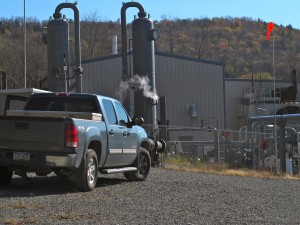DEP says gas drilling air pollution a small fraction of Pa. emissions

Katie Colaneri/StateImpact Pennsylvania
A compressor station pumps natural gas into the Tennessee Pipeline in Dimock, Pa.
A new report from the Department of Environmental Protection found that air pollution from Pennsylvania’s natural gas industry represented a small fraction of the state’s total emissions in 2012, despite including more emissions data from compressor stations than in 2011.
Here are the new stats from the DEP:
- 16,361 tons of nitrogen oxides, a 1.09 percent decrease from 2011
- 101 tons of sulfur dioxide, a 17.21 percent decrease from 2011
- 7,350 tons of carbon monoxide, a 7.27 percent increase from 2011
- 548 tons of particulate matter (PM2.5), a 8.51 percent increase from 2011
- 600 tons of PM10, a 3.99 percent increase from 2011
- 4,024 tons of volatile organic compounds, a 42.70 percent increase from 2011
Joyce Epps, Director of DEP’s Bureau of Air Quality, said that nitrogen oxides, or NOx, and volatile organic compounds (VOCs) are among the most significant emissions. Ozone is formed when VOCs and NOx react with sunlight.
In 2012, the natural gas industry in Pennsylvania saw a roughly one percent drop in NOx emissions. Epps said the department owes this decrease to a slowdown in drilling operations in Pennsylvania. She noted that the drilling rigs that bore deep into shale rock formations are the biggest NOx emitters in the natural gas development sector, accounting for more than 6,200 tons.
“Overall the [NOx] emissions from this sector account for only ten percent of total [NOx] emissions from all point sources including electric generating units,” Epps said. “It’s a much smaller number when you look at the total picture.”
However, the industry’s emissions of VOCs increased by more than 40 percent in 2012.
In its first report in 2011, the DEP did not include emissions from compressor stations at conventional, or vertical drilling operations. Compressor stations help keep gas under pressure and move it along pipelines. In 2012, DEP gathered emissions data from 250 additional conventional compressors and processing stations.
“What you’re now having is not so much increase in emissions into atmosphere, but an increase in the number of sources reporting,” Epps said.
In a press release, the DEP stressed that Pennsylvania’s cumulative air emissions have been on the decline since natural gas drilling ramped up in 2008.
“It is important to note that across-the-board emission reductions in emissions can be attributed to the steady rise in the production and development of natural gas, the greater use of natural gas, lower allowable emissions limits, installation of control technology and the deactivation of certain sources,” Secretary Chris Abruzzo said in the release.
















